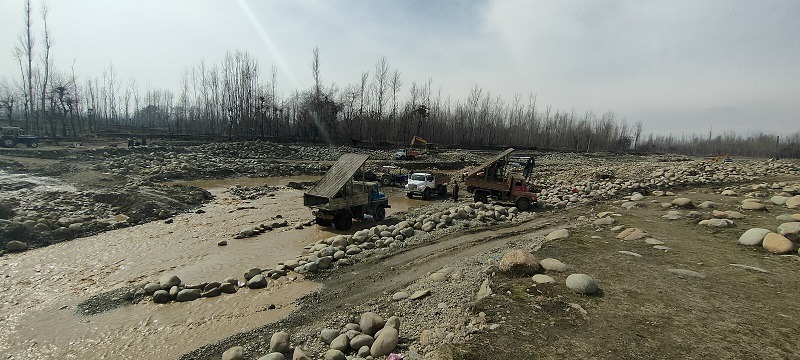Case Name: Union Territory of J & K (Previously State of Jammu & Kashmir) & Anr. v. Raja Muzaffar Bhat & Ors.
Case Number: Civil Appeal No. 8055 of 2022 (with Civil Appeal No. 68 of 2023 and Civil Appeal No. ___ of 2025 @ Diary No(s). 1007 of 2025)
Date: 22 August 2025
Quorum: Hon’ble Mr. Justice Pamidighantam Sri Narasimha and Hon’ble Mr. Justice Atul S. Chandurkar
Facts
The case is concerned with the grant of environmental clearances (EC) regarding the sand mining operations in the identified blocks of Shaliganga Nallah and some of the riverbed, mining sites in Jammu & Kashmir. The project proponent filed numerous proposals for mining, which were rejected initially by Jammu & Kashmir UT Expert Appraisal Committee (EAC), on the ground of extracting from over exploited areas, and District Survey Report (DSR) inadequacies, especially not having any replenishment. However, despite all this, the EAC later recommended the approval after issuing a “Fit for Mining Certificate” from the Geology and Mining Department and, the State Environment Impact Assessment Authority (SEIAA) granted the EC, also limiting the depth of mining to 1 meter in the absence of replenishment studies. The grant of EC was challenged before the National Green Tribunal (NGT), which set aside the EC for all violations with the environmental laws, and is now before the Supreme Court in present appeals.
Issues
Whether the grant of EC for sand mining without a DSR prepared in accordance with the guidelines (especial the non-issued one having replenishment data) is valid.
Whether the operationalization of mining activities of up to 1 meter depth without replenishment studies can cure the absence of a proper DSR.
What are the compliance with conditions, and environmental laws by the project proponent, and if heavy machinery was entirely prohibited or alleged to be used.
Legal Provisions Involved
Environment (Protection) Act, 1986: Empowers the Central Government to control activities that cause environmental pollution.
Mines and Minerals (Development and Regulation) Act, 1957 (MMDR Act): Regulates minerals development activities but does not focus on the protection of the environment.
EIA Notification 2006 (amended in 2016 & 2020): Requires EC for mining and specifies how to obtain EC through DEIAA, DEAC and describes detailed provisions for DSR including the conduct of replenishment studies.
Sustainable Sand Mining Management Guidelines, 2016 and Enforcement and Monitoring Guidelines for Sand Mining, 2020: Require issues like the scientific preparation of DSR and replenishment studies for EC to be permitted in the first instance.
J&K Minor Mineral Concession, Storage, Transportations of Minerals and Prevention of Illegal Mining Rules, 2016: Regulate the mining of minerals, at the state level.
Arguments
Petitioners’ Arguments
the EC was valid because it limited the mining operation to 1 meter, which was alleged to limit or mitigate the environmental risk even though replenishment studies had never been conducted.
The DSR, though defective, was enough to provide a basis for grant of EC because of the emphasis on public interest in developing infrastructure (i.e., building highways).
There was no specific legal requirement that made replenish studies mandatory to be granted EC, as long as other safeguards were complied with.
Respondents’ Arguments
The Environmental Clearance (EC) was outright unlawful, since it was built on a DSR which failed to comply with the statutory requirements, particularly missing replenishment data.
The 1-meter depth of mining restriction was not a substitute for a scientific study, and did not address cumulative and long-term environmental impacts.
The grant of EC without compliance with the EIA Notification and the sand mining guidelines undermined environmental law and the potential for environmental degradation.
Analysis
The Supreme Court painstakingly traced the development of environmental law on sand and minor minerals mining in India, noting the explicit legal requirement and policy direction to undertake scientific DSRs, particularly for replenishment studies, as a condition precedent to EC. It cited prior landmark cases (like Deepak Kumar v. State of Haryana) noting that the EIA Notification 2006, its 2016 amendment, and the specific binding guidelines require preparation of a DSR that is updated and scientifically based (specifically including replenishment data) before EC can be granted. The Court concluded that both the EAC and SEIAA had skipped a clear legal requirement by proceeding based on a deficient DSR, and errantly tried to compensate for non-compliance by simply restricting the depth of mining.
Judgment
The Supreme Court affirmed NGT’s decision to set aside the EC given to the appellants, concluding that any DSR without a replenishment study is unreasonable, and cannot give rise to a valid EC. Further, the attempt to “compromise”, by restricting the depth of the mining would have no legal basis as there was no provision in law to make that departure in the absence of a DSR. The appeal was denied. Lastly, the Court upheld NGT’s direction to the Pollution Control Board to take action against known cases of illegal level using heavy machinery and did not find any violation of the J&K minor mineral rules that justified appellate jurisdiction.
Conclusion
This judgment reinforces the principle that environmental clearances for mining should be unequivocally conditional upon scientific appraisal, and replenishment studies are necessary. It also sets down a key precedent establishing that administrative expediency or “limited” mining cannot override legally mandated procedural safeguards, always placing sustainable development and environmental security above infrastructure or economic considerations. The Supreme Court made a principled stand to safeguard regulatory integrity and mitigate regulatory failure in environmental management.
“PRIME LEGAL is a full-service law firm that has won a National Award and has more than 20 years of experience in an array of sectors and practice areas. Prime legal falls into the category of best law firm, best lawyer, best family lawyer, best divorce lawyer, best divorce law firm, best criminal lawyer, best criminal law firm, best consumer lawyer, best civil lawyer.”
WRITTEN BY __ Kondala Phani Priya


